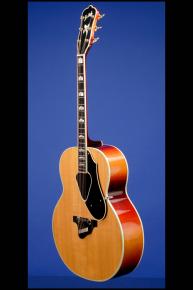1951 Gretsch 6040 Synchromatic 400F FlatTop
"Extremely Rare...Only a Few Are Known To Exist"
This incredible 18-inch-wide , 4 1/3 inches deep, Jumbo Flat Top weighs just 6.20 lbs. and has a nice, fat nut width of just under 1 3/4 inches and a scale length of 25 1/2 inches. Close-grained "X-Braced" spruce top. Highly figured book-matched 'quilted' curly maple back and sides. Asymmetrical, non-trussrod Gretsch "miracle neck" (three-piece flamed maple neck with two mahogany center-strips) and a wonderful medium profile. Ebony fretboard, each side with five -ply binding including one layer of gold sparkle. Twenty medium frets and inlaid pearl hump-top block position markers, each with two gold sparkle 'slashes'. The top and back of the body have super ornate eleven-ply mainly black and white binding (one of the rings is gold sparkle), the 'triangular' soundhole has five black and white rings and one in gold sparkle. The butt end of the neck has a matching six-ply (including one gold sparkle) ornamentation piece. "The butt inlay, the area at the bottom of the guitar where the two sides meet, is an extraordinary array of twenty laminates of black, white and gold sparkle plastic, completing the most garishly appointed guitar of the Art Deco, or any other, era" (Jay Scott). Black (pyralin plastic) faced 'light-bulb' shaped headstock with five-ply binding including one in gold sparkle. Headstock face with hand-cut mother-of-pearl slanted script "Gretsch", mother-of-pearl 'lightning bolt' engraved "Synchromatic" which in turn crosses a mother-of-pearl 'chili-pepper' ornament. Back of headstock also finished in black pyralin. Individual Grover Imperial tuners with gold-plated stair-step metal buttons (the 'D' tuner has at some time been changed for a slightly later version). Unique shaped raised (about 1/4 inch) black triple-bound celluloid pickguard with three screws. Gretsch stairstep "synchrosonic" ebony bridge on ebony base. Gretsch "Chromatic" harp-shaped ebony tailpiece with gold-plated 'ridged' stop-bar. With the Gretsch white rectangular label inside the sound-hole with style model "400 6040" stamped in black and the serial number "5364" stamped in brown. This guitar is in near mint (9.25) condition with just one insignificant surface mark on the top. There are no 'binding' issues as is so often the case with early Gretsch's, no visible playing wear and even with the tiny mark on the top and the changed "D' tuner button this is most certainly the finest example in existence of this legendary musical rarity. Housed in the original Lifton four latch brown hardshell case with purple plush lining (9.00).
The model number on this guitar is "6040" - yet Jay Scott refers to the 400F as being model number "6042"… we believe that the "6042" designation was for an all natural finish guitar with tortoiseshell plastic binding as played by Johnny Smith before he moved to Guild and the "6040" designation was for a guitar with 'sunbursted' back and sides.
Introduced in 1940 to compete with Gibson's popular Super 400, the opulent Synchromatic 400 featured an 18" wide, non-cutaway body with maple back and sides; double bound cat-eye sound holes; stairstep "synchrosonic" bridge; "chromatic" harp tailpiece; pickguard with white and gold sparkle binding that almost covered the treble sound hole; white and gold sparkle fingerboard and body binding; 26" scale; gold plated parts; 5 piece neck of maple and rosewood; ebony fingerboard; slanted script "Gretsch" logo; crossed "Synchromatic" chili-pepper inlay ornament; and slashed humptop block inlays. It was a beautiful Art Deco masterpiece.
In 1947, Gretsch introduced a flattop version called the Synchromatic 400F, similar to the 1940-1954 Synchromatic 400 except for its flat top, triangle sound hole, and improved ebony bridge and tailpiece. "The 'Super Auditorium Sized' 400F Model 6042 was the largest production flattop guitar offered by any American manufacturer at this time" (Scott, Jay. The Guitars of the Fred Gretsch Company, p. 29). In comparison, it makes Martin's dreadnaught-sized bass guitar look like a ukulele. "This deep-toned...18" body guitar with its wonderful 'singing bass'" (1949 Gretsch catalog), is Synchromatic at its best, a luxurious sound and design symphony lavishly and lovingly crafted with obsessive attention to functional and decorative detail. The "singing bass" was facilitated by the guitar's "asymmetrical" neck, which in cross-section was heavier on the bass side than on the treble. This ultra-thin, 26" scale "Miracle Neck" was built for speed; jazz guitarist Harry Volpe claimed that "my fingers seem to travel twice as fast on my new Synchromatic." It feels like you're ice-skating up and down the neck. The action is soft and relaxed. The strength of the "Miracle Neck" is reinforced by its multi-laminate ebony fingerboard. The Art Deco-inspired 24k gold-plated Grover Imperial tuners, pegs, and stair-step metal buttons are a handsomely stylish touch. The mother-of-pearl fingerboard inlays, and elaborate, extravagantly multi-plied binding around the body, butt-inlay, headstock and sound hole feature subtly elegant in-lines of gold sparkle. The figuring on the rear of the guitar is so intensely flamed that it appears that an arsonist set a match to it and you may want to consider wearing asbestos when playing this fine instrument.
It was Gretsch's post-war acoustic piece de resistance, an easily tamed "boomy, bassy monster" yet "the 400F flattop Model 6042 is extremely rare today and only a few are known to exist" (Jay Scott. The Guitars of the Fred Gretsch Company, pp. 28-29).










